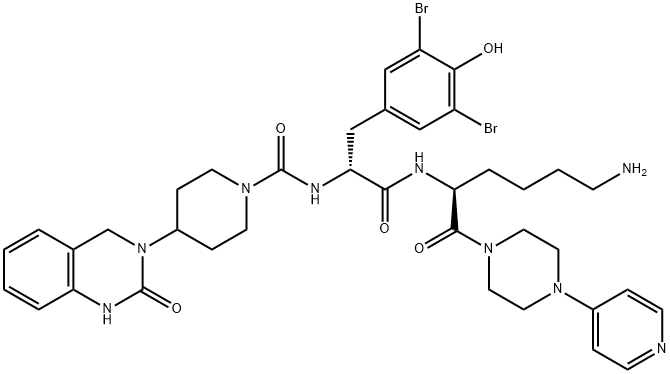204697-65-4
 204697-65-4 結(jié)構(gòu)式
204697-65-4 結(jié)構(gòu)式
基本信息
Olcegepant
BIBN 4096BS
BIBN 4096BS API Olcegepant
1-[3,5-Dibromo-N-[[4-(1,4-dihydro-2-oxo-3(2H)-quinazolinyl)-1-piperidinyl]carbonyl]-D-tyrosyl-L-lysyl]-4-(4-pyridinyl)-piperazine
Piperazine, 1-[3,5-dibromo-N-[[4-(1,4-dihydro-2-oxo-3(2H)-quinazolinyl)-1-piperidinyl]carbonyl]-D-tyrosyl-L-lysyl]-4-(4-pyridinyl)-
N-[2-[5-Amino-1(S)-[4-(4-pyridinyl)piperazin-1-ylcarbonyl]pentylamino]-1(R)-(3,5-dibromo-4-hydroxybenzyl)-2-oxoethyl]-4-(2-oxo-1,2,3,4-tetrahydroquinazolin-3-yl)piperidine-1-carboxamide
物理化學(xué)性質(zhì)
常見(jiàn)問(wèn)題列表
IC50: 0.03 nM (CGRP1)
Ki: 14.4 pM (hCGRP)
Olcegepant possesses higher affinity for the human CGRP receptor than the endogenous ligand CGRP and 150-fold higher affinity compared to the peptidic antagonist CGRP8-37. Olcegepant reverses CGRP-mediated vasodilation in human cerebral vessels and inhibits neurogenic vasodilation in a surrogate animal model of migraine pathophysiology. Olcegepant (BIBN4096BS) is extremely potent at primate CGRP receptors exhibiting an affinity (K i ) for human CGRP receptors of 14.4±6.3 (n=4) pM. Several lines of evidence suggest that a calcitonin-gene related peptide (CGRP) receptor antagonist may serve as a novel abortive migraine treatment. Olcegepant (BIBN4096BS) exhibits competitive antagonism at the CGRP receptor present in SK-N-MC cells. Isolated human cerebral, coronary, and omental arteries are studied with a sensitive myograph technique. CGRP induces a concentration-dependent relaxation that is antagonized by Olcegepant in a competitive manner.
Olcegepant (BIBN4096BS) in doses between 1 and 30 μg/kg (i.v.) inhibits the effects of CGRP, released by stimulation of the trigeminal ganglion, on facial blood flow in marmoset monkeys. Pre-treatment with Olcegepant (900 μg/kg) inhibits the capsaicin-induced expression of Fos throughout the spinal trigeminal nucleus by 57%. In contrast, the expression of phosphorylated extracellular signal-regulated kinase in the trigeminal ganglion is not changed by Olcegepant pre-treatment. Olcegepant (0.3 to 0.9 mg/kg, i.v.) markedly reduces mechanical allodynia in CCI-ION rats. Olcegepant (0.6 mg/kg, i.v.) significantly reduces the number of c-Fos immunolabeled cells in spinal nucleus of the trigeminal nerve and upregulation of ATF3 transcript (a marker of neuron injury) but not that of interleukin-6 in trigeminal ganglion of CCI-ION rats.